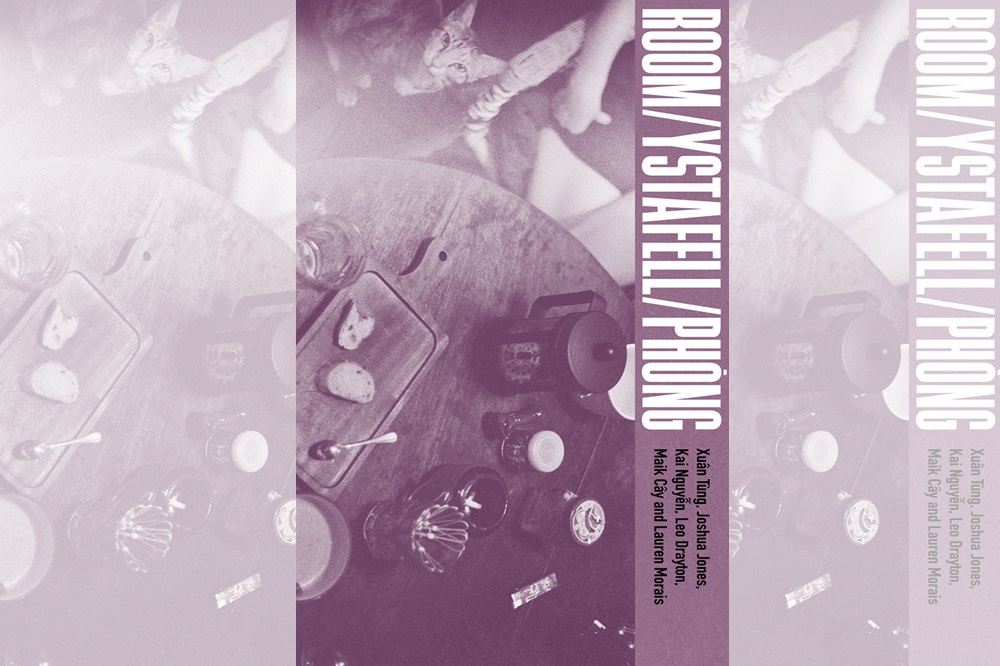Book review: Room/Ystafell/Phòng

Alex Wales
Born from a collaboration between six writers from Wales and Việt Nam, Room/Ystafell/Phòng explores space, its queer nature and how we find room for our identity – and how we can use it to connect with each other.
Containing various media – prose, chatroom transcripts, non-fiction prose, letter/prophecy, photography, collage – this work holds something for each and every one of its readers with the promise that each piece will provoke the reader with new thoughts.
Each and every one of the collected writers’ works brings something to the table that is deeply moving. The book is split up into six sections – one for each writer – and interspersed with short, 1 or 2-page excerpts from a group text log.
The chatrooms are an included work; each one contains a question, often posed by project lead Joshua Jones, and its subsequent replies. For instance, he asks the artists for their definitions of queer, and each reply is built upon by others.
This remarkably personal look into the online exchanges between the writers lends the works that follow a more poignant quality; we are given an insight into their conversational thoughts, and it provides their work a welcome context.
This particular excerpt ends with Maik Cây’s declaration that “queer is love. / What we have here today as a tiny community is love.”
Mystic
Xuân Tùng begins with Tỏa bóng – The divine shade, an account of his first time voguing in the capital of Hà Nội, post-pandemic. It’s a tale as old-as-time to some queer-folk, and the manner in which he blends the tale of the hau dong ritual with the nature of voguing is insightful.
We learn of mediums, religious figures who take on feminine appearances in the act of ritual – despite the accusations of homosexuality that come with it.
It reflects a balance between the mystic and common queer life, asking the reader to rethink how some traditions blend with queer culture and expressions of identity – and especially how those traditions are enabled and used by those who still choose to sneer or shy away in the same breath.
In an essay that reaffirms the queer desire to have a chance at living in the real world, Tùng asks of being queer, “Is it our job to be stars and spectacles?”
Unease
In thoughts of a 22-year-old Cardiff lesbian at 2am, Lauren Morais is “charging down Queen Street with ‘hot welsh gay’ charred on [her] chest” (photo proof of t-shirt included) – a blazing rumination on appearing queer, holding hands in public and whether it’s safe despite modern times.
She captures the unease and anxiety felt by those who start to question things in the early hours of the morning as the piece ends just as soon as it started.
Despite its length her work encompasses large themes, reaching round to encompass the whole of her thoughts and ours.
Morais puts the world to rights with a short, quiet yet loud determination – demanding a path for the Cardiff queer and all the queers in the world as she declares, “I vow to be messy and too much.”
Extravagant
Speaking of affirmations – Maik Cây puts forth a wonderfully experimental piece of prose – I call it that, because I’m unsure of what else it is. Formatted as a reply letter to the daughter of a former lover, Cây’s narrator sets forth Thập-Quái-Mộng (The Ten Queer Dreams).
The letter is extravagant to navigate, reading like prophecy. I found myself poring over it, fascinated with the way in which their words swept through imagery, and language, and the space of the queer in both the real and metaphysical worlds.
The tight worldbuilding of the letter and its accompanying dreams is a marvel to read. At the end, Cây’s narrator states with such quick passing you would not notice unless reading for a second, or third time, “Nature is the only thing that tolerates my pathetic existence.”
Stylised
The cover, a photo of a table laden with various implements surrounded by fading limbs and the inquisitive stare of a cat is overlaid with a purple-pink haze, accompanied by thick-white block lettering spelling ROOM/YSTAFELL/PHÒNG, with the names of six authors sitting in a quiet black strip next to it.
It presents a dreamy and stylised start to the collection which is sure to be continued as a theme throughout.
Despite the amount of content I felt I had read through, the collection comes in at only 78 pages. I’ve only covered the first three writers – the six together make a wonderful collection that is well worth the time spent reading.
Much of the work in Room reads as affirmation – prayer-like in their reminders of what being capital-Q Queer is, and how to make and embrace the space it needs to breathe.
I highly recommend those interested to grab a copy, and read – re-read it again, and look forward to future work from its authors.
Room/Ystafell/Phòng ís published by Parthian and is available from all good bookshops.
Support our Nation today
For the price of a cup of coffee a month you can help us create an independent, not-for-profit, national news service for the people of Wales, by the people of Wales.




